George Romero movies, ranked

- Oops!Something went wrong.Please try again later.
- Oops!Something went wrong.Please try again later.
- Oops!Something went wrong.Please try again later.
- Oops!Something went wrong.Please try again later.
- Oops!Something went wrong.Please try again later.
- Oops!Something went wrong.Please try again later.
Born in the Bronx and raised in Pittsburgh, PA — where he would go on to lens his most famous films — George Romero, the director of Spanish-Lithuanian descent who was called "the Father of the Zombie Movie" by the New York Times, essentially invented the flesh-eating ghoul genre as we know it with his feature debut Night of the Living Dead (1968). As a child growing up in the '40s and '50s, Romero was fascinated by the science-gone-wrong thrillers of that era, B-grade pictures which used the deceptively simple symbols of mad scientists, crazed killers and atomic monsters to smuggle to their audiences more subversive messages about post-war society. "I grew up on the Famous Monsters of Filmland," Romero once told NPR of the definitive horror-centric magazine, which was first printed in 1958 and acted as the prototype for publications such as Fangoria and Video Watchdog. Originally published by James Warren and edited by Forrest J Ackerman, Famous Monsters covered a wide range of genre topics but, in its early days, was especially reverent towards silent films and thrillers of the '30s, all of which would influence Romero throughout his career.
After graduating from Carnegie Mellon University in 1960, Romero began working as a director of commercials as well as industrials and training films. One of the young filmmaker's first jobs was for none other than Mr. Rogers himself; Romero shot a sequence for Mr. Rogers' Neighborhood in which the eponymous gentleman undergoes a tonsillectomy. (It's titled, fittingly, Mr. Rogers Gets a Tonsillectomy.) In the late '60s Romero, along with filmmakers John A. Russo (co-writer of Night of the Living Dead) and Russ Steiner (who played Johnny in Living Dead), formed Image Ten Productions. Under that banner, the trio would go on to produce Night of the Living Dead and revolutionize horror filmmaking forevermore. In his original 1968 review of the film, Roger Ebert remarked upon the audience's unpreparedness for the onslaught of bleak violence and terror in a casual weekend matinee showing. "The kids in the audience were stunned. There was almost complete silence. The movie had stopped being delightfully scary about halfway through, and had become unexpectedly terrifying. There was a little girl across the aisle from me, maybe nine years old, who was sitting very still in her seat and crying. I don't think the younger kids really knew what hit them. They were used to going to movies, sure, and they'd seen some horror movies before, sure, but this was something else…I felt real terror in that neighborhood theater last Saturday afternoon."
That real terror continues to run and run. Night of the Living Dead is one of the most famous films in the world (in 2021 it was ranked as the second-most downloaded movie on the Internet Archive) and spawned two direct sequels from Romero — Dawn of the Dead (1978), which was produced with tremendous assistance from the baron of Italian horror himself Dario Argento, and Day of the Dead (1985). (Ebert called Dawn of the Dead "one of the best horror films ever made" upon its original release, noting additionally that "nobody ever said art had to be in good taste.")
In his aforementioned NPR interview, Romero said that he had "a soft spot in my heart for the zombies. They are multipurpose, you can't really get angry at them, they have no hidden agendas, they are what they are. I sympathize with them." When asked if he ever anticipated making such an indelible impact on the horror genre, Romero demurred. "All I did was I took [zombies] out of 'exotica' and I made them the neighbors. I thought there's nothing scarier than the neighbors!"
After completing his initial Dead trilogy in 1985, Romero would go on to direct seven more films before he passed away in 2017 at the age of 77 following a short battle with lung cancer. In addition to his flesh-eating masterworks, Romero directed the underseen modern-jousting epic Knightriders (1981), the classic anthology Creepshow (1982), and the '50s throwback Monkey Shines (1988). In 2004, he returned to the zombie fold with Land of the Dead, which began a new Dead trilogy that Romero rounded out with Diary of the Dead (2007) and Survival of the Dead (2009). His legacy lives on both in the form of his immense filmography as well as his continuing franchises. Day of the Dead has been rebooted several times, most recently as a Syfy Channel series which premiered in 2021, while a remake of Night of the Living Dead, with Nanny's Nikyatu Jusu attached to direct a script by The Walking Dead's LaToya Morgan, aims to reboot the franchise once more.
George Romero would've been 82 this February, so to celebrate the man and his body of work, EW has ranked each of the director's 17 feature films below.
17. <i>There's Always Vanilla</i> (1971)
Chris (Raymond Laine) returns from combat to his native Pittsburgh and to a father who eagerly hopes his son will take over the family business. Chris instead decides to panhandle and scrape by day-to-day, but when he meets Lynn (Judith Streiner), a talented model and actress, the two immediately hit it off and fall into an all-consuming courtship. Lynn soon tires of supporting her lay-about boyfriend and when she gets pregnant and must consider an abortion, her life with Chris may be permanently altered.
A surprisingly contemptible stab at post-Graduate counterculture hipness mixed with post-Love Story teary-eyed woe, Vanilla ends up being a bit of a proto-mumblecore movie, though notably not one of the cute ones upon which Greta Gerwig cut her teeth. There is none of Romero's signature style here, nor anything of substance he has to say about his characters. It's also an oddly conservative film, one that doesn't mesh with the subtexts of Romero's later pictures. (The title refers to a third-act conversation Chris has with his father, in which the old man compares life to an ice cream stand offering exotic flavors "but there's always vanilla" to go back to. Yikes!)
The finale, too, is laughable and infuriating in equal measure. Unable to go through with an abortion, Lynn gives up her dream and returns to her vanilla-flavored high school boyfriend (yikes!) who is rather too eager to raise Chris' progeny as his own. Much later, Chris sends a package to Lynn which contains a set of balloons (which serve no purpose but to escape the box and pollute our delicate atmosphere) and a letter which implores the woman he took advantage of and left to bear his child to simply remember the good times they had together. (Really yikes.) The feelings we are left with are frankly not suitable to print. For that matter, neither was the film.
If you loved There's Always Vanilla, you might also enjoy: Death Dream (1974), a Monkey's Paw tale centering around a resurrected Vietnam soldier directed by Bob Clark (Black Christmas, Porky's, A Christmas Story).

16. <i>Survival of the Dead</i> (2009)
Informed of a safe zone amidst a world overrun by zombies, a squadron of soldiers led by Alan Van Sprang's Sergeant Crockett travels just off Delaware's coast to Plum Island in the hopes of starting a new life. What they discover is far from idyllic though, as the men wander into a feud between two families — one which exists peacefully amongst the undead, and another which wishes to exterminate all of the ghouls.
Romero's final film is also one of his worst, a turgid blend of soap opera and horror that seems to have little interest in advancing itself forward. Remarkably boring and often quite nihilistic, Survival plays like an episode of The Walking Dead made by Michael Bay. Which is to say, it's a lot of gruff military men yelling at each other in the woods for extended intervals punctuated by some noisy gunplay and a dollop of sexism for good measure. There is one memorable image of a zombie riding horseback that recalls the sweep and promise of Romero's earlier work, but that comprises only four seconds of this 90-minute slog.
If you loved Survival of the Dead, you might also enjoy: 28 Days Later (2002), which covers some of the same ground in a far more accomplished manner.
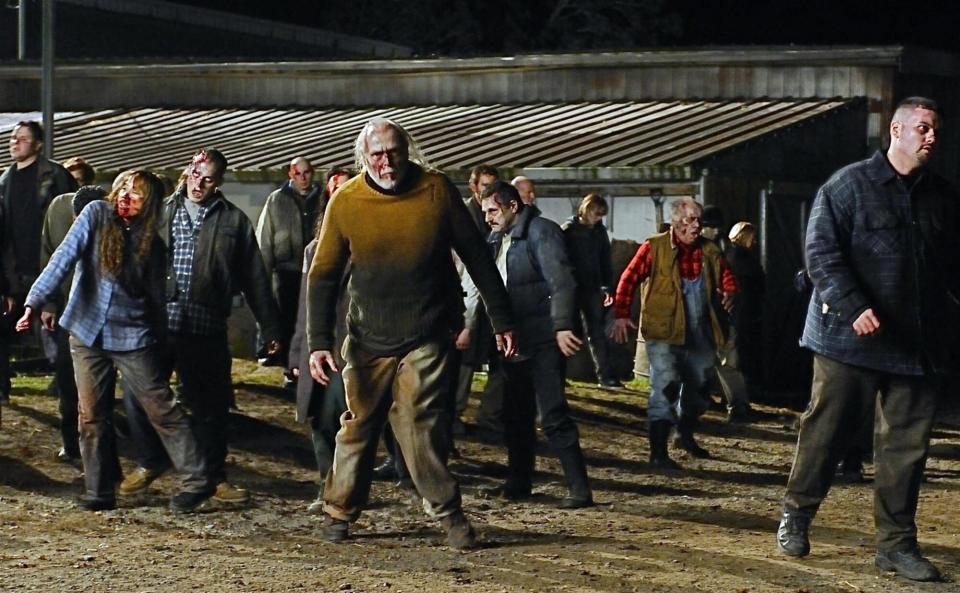
15. <i>Two Evil Eyes</i> (1990) – "The Facts in the Case of Mr. Valdemar"
Jessica Valdemar (Creepshow star Adrienne Barbeau) and her boyfriend Dr. Robert Hoffman (Ramy Zada) are conspiring to defraud Jessica's elderly husband Ernest (Bingo O'Malley). Just as Jessica is about to be handed her husband's substantial estate, with the stipulation being that Mr. Valdemar cannot perish in the next three weeks, her husband is killed in an accident. She and Robert attempt to hide the body, and as Ernest lies entombed in the basement trapped between the world of the living and the dead, the house itself becomes a portal through which the deceased may enter our world.
Inspired by the tales of Edgar Allan Poe, this dual-story anthology (the other installment of which was directed by Romero's frequent collaborator Dario Argento) appears to be poised as something of a continuation and inversion of the Creepshow milieu. It's not particularly successful, though, in part because the filmmaking cannot sell the style either story needs to work as any sort of a companion to Poe. (The visual language here is along the lines of late-'80s gialli such as Blade in the Dark and Delirium, which is to say flagrantly televisual and obscenely overlit.)
Romero's tale, despite featuring a typically committed and highly watchable lead turn from Barbeau, suffers from a predictable arc and a deadly sense of repetition. By the time the story rolls around to its conclusion, one must wonder if Romero had his heart in the enterprise. Originally, the film was set to feature four stories with a different director tackling each, but when John Carpenter and Stephen King both left their respective assignments, the film was retooled. It's an odd experiment — Argento and Romero do not share complimentary styles, nor does this film cohere them in any way — and one can feel the strain on both of their parts to stretch their stories into feature length.
If you loved Two Evil Eyes, you might also enjoy: Lucio Fulci's A Cat in the Brain (1990)

14. <i>Land of the Dead</i> (2005)
The living dead have officially taken over the world, but in Pittsburgh, a small faction eke out a meager life in a fortified city, within which exists a feudal society overseen by the vicious Paul Kaufman (Dennis Hopper).
Land of the Dead will be all-too-familiar to those of us who watched, with bated breath, as John Carpenter self-destructed at the end of the '90s and into the early 2000's. What is it about these '70s directors and their energy that worked so effortlessly in that decade and the one immediately following, but which looks so cheap and washed-out when adorned with aughties effects and budgets? Certainly the talented cast (among them John Leguizamo, Simon Baker, and Asia Argento, Dario's daughter) being styled to look equivalent to WB (sorry, CW) stars doesn't help, but the problems run much deeper. There is a lack of energy, even purpose, to the film and the performances within it, as if we're watching a blocking rehearsal, or perhaps even the very first table read, as opposed to the finished product.
In his EW review, Owen Gleiberman wrote that "the prospect of a brand-new living-dead picture written and directed by George A. Romero is more than enough to flood your zombie nostalgia receptors…[but] I'm compelled to report that in Land of the Dead there are virtually no good parts. The movie is listless and uninspired."
If you loved Land of the Dead, you might also enjoy: Doomsday (2008)
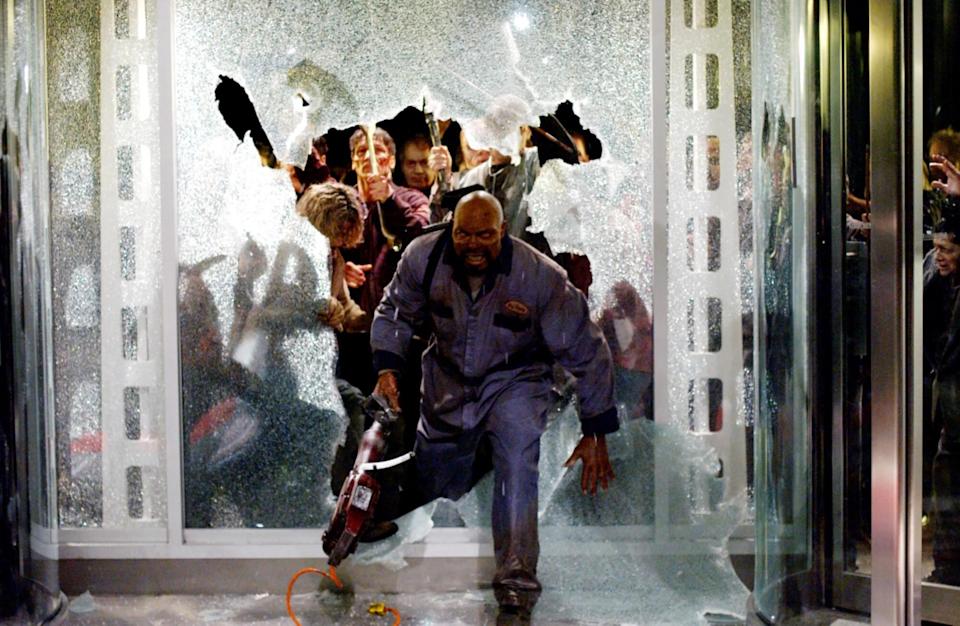
13. <i>Diary of the Dead</i> (2007)
A merry gang of film students, out and about shooting a low-budget horror movie, accidentally stumble upon the zombie apocalypse and manage to capture the chaos on their consumer-grade camcorder.
Lurking beneath the cheesy charms that comprise the majority of Diary of the Dead are some of the sharp satirical ideas that shaped Romero's best work. In what became a trend throughout the director's career, Diary's message is perhaps even stronger now than it was at the time, as the film weaves a rather prescient nightmarescape of digital media while getting in some juicy jabs at the morality of documentary filmmaking.
"It's maybe the angriest movie I've made since Night," Romero told an audience at a preview screening for the film at the Museum for the Moving Image in New York. "There's a hell of a lot more I'd like to say about this media octopus that doubles in size every hour… You see something happening outside your window, get a shot of it, send it in, we'll put it on the air and send you a CNN mug… I say, not so facetiously, that if Jim Jones had a blog, he'd have millions of people drinking the Kool-Aid."
Owen Gleiberman wrote in EW's review of the film that "Diary of the Dead isn't bad; it's a kicky B movie hiding inside a draggy, self-conscious-work-of-auteurist-horror one. There are some gruesomely imaginative deaths, the kind that get you laughing because they're as snappy as speed-metal power chords… And when the stalking dead are viewed on a flickering home-surveillance system, it has a grand and creepy immediacy."
If you loved Diary of the Dead, you might also enjoy: REC (2007)
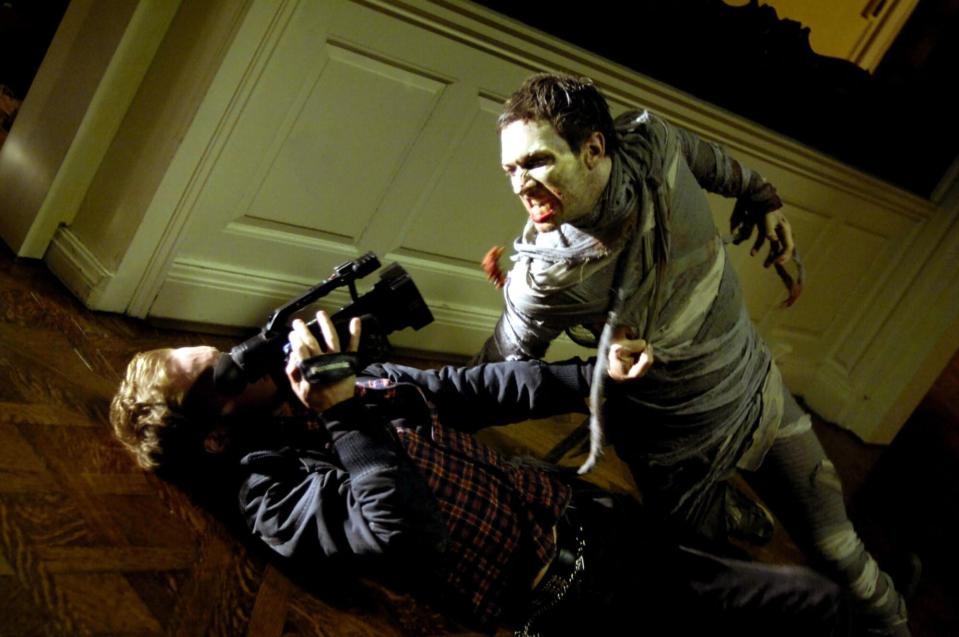
12. <i>The Amusement Park</i> (1975)
Romero helmed this deeply disturbing industrial-cum-psychological-horror, which the Lutheran Society commissioned from the director in between his work on The Crazies and Martin. The Amusement Park is a bleak 55-minute affair which begins with star Lincoln Maazel speaking directly to camera, identifying himself as an actor before going on to address the audience regarding the mistreatment and abuse of the elderly community. The film itself follows Maazel as a variety of characters, but most notably a sweet older man who sets out for a fun day at his local amusement park but is instead met with the humiliations of aging (and ageism) at every turn.
Considered lost to time before it was acquired and distributed by Shudder in 2021, The Amusement Park digs in so deeply to the most uncomfortable parts of North American culture that at times it's barely watchable. You'd be hard-pressed to find an American film that deals more directly with our culture's ignorance, repulsion, and outright malevolence toward the older population. Romero handles these themes in admirably unblinking fashion, his stylistic choices here a cross between Dali-esque surrealism and gritty social realism that looks forward to the work of British filmmaker Ken Loach. It's a tough watch, but a worthy and oddly satisfying one.
If you loved The Amusement Park, you might also enjoy: I, Daniel Blake (2016)
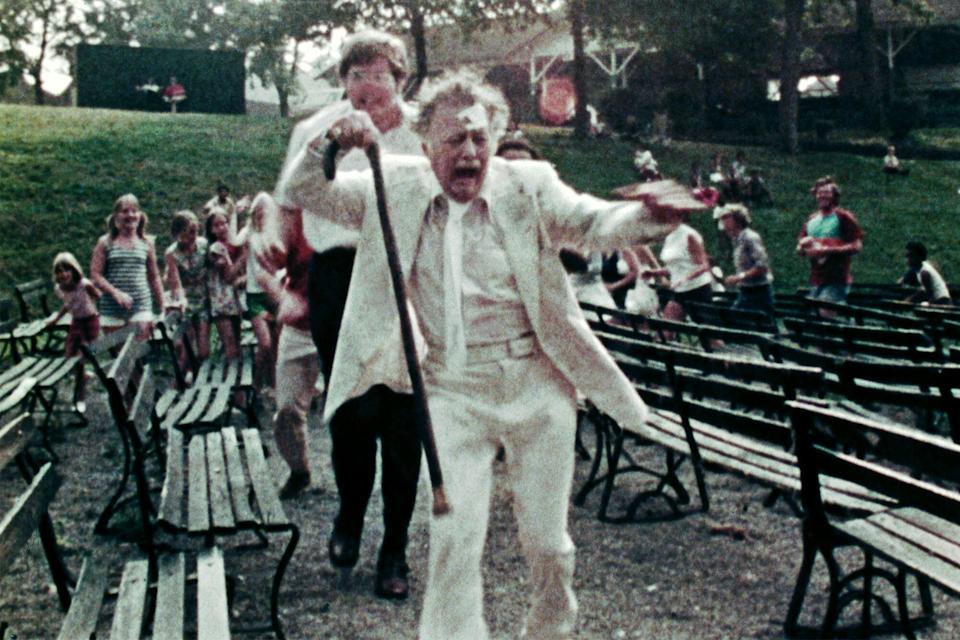
11. <i>The Dark Half</i> (1993)
Thad Beaumont (Timothy Hutton) is a successful novelist who publishes glossier fiction under his real name and uses the alias of George Stark to write violent, financially successful thrillers. After Beaumont's ruse is exposed, the author holds a funeral for Stark as a publicity stunt. Yet soon after Stark's "burial," gruesome murders begin to occur that are straight from the pages of the supposedly fictional author's novels. The finger of accusation now pointing at him, Thad must join forces with his wife Liz (Amy Madigan) and the town sheriff (Michael Rooker) to uncover the truth behind George Stark.
The Dark Half, based on Stephen King's 1989 novel of the same name, is a fairly compelling popcorn thriller that nevertheless finds Romero in highly impersonal territory, crafting a screen version of King's work that feels stylistically similar to a few too many of the author's adaptations. It's somewhat disappointing that Romero, a director who in his early work couldn't help but capture the dualities of human emotion, cannot elicit more suspense here in regards to the truth of Stark's identity.
Still, it's an entertaining (if overlong) journey with some cracking sequences of suspense and one particularly nasty murder set piece. The film's best scenes are the domestic snapshots of Hutton and Madigan, who have an easy rapport and convincingly embody a long-betrothed couple going through an unimaginable rough patch.
If you loved The Dark Half, you might also enjoy: Dario Argento's Tenebrae (1982)
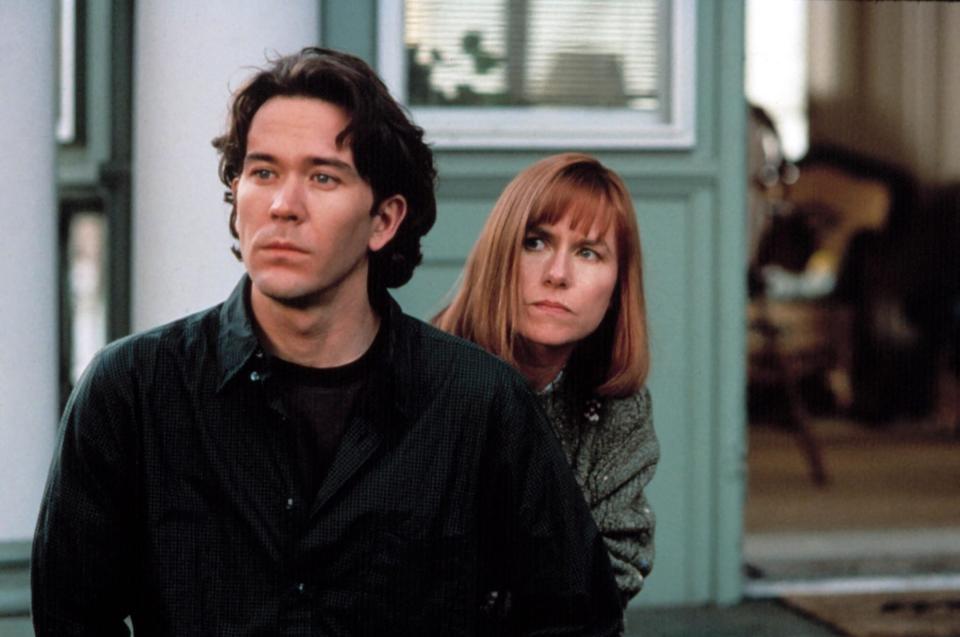
10. <i>Season of the Witch</i> (1972)
Feeling increasingly estranged from her husband Jack (Bill Thunhurst) and their college-age daughter Nikki (Joedda McClain), disillusioned housewife Joan Mitchell (Jan White) embarks upon a friendship with a new woman in town who also happens to head the local coven of witches. Soon, Joan is using witchcraft to benefit her everyday life and repair her marriage, but her dabbling in the dark arts is to have unintended consequences within her real world.
The period between Night of the Living Dead and Martin is often considered Romero's least furtive in terms of the quality of films he produced, and while Season of the Witch is far from an unbridled success, it does offer enough to distinguish it from the rest of the director's catalog. Season of the Witch finds Romero crafting a film along the lines of Ingmar Bergman's work, which in the decade previous to this film's release were at the height of their popularity in the United States. By the time Season of the Witch was finished, Bergman's hold on North American audiences had loosened, leaving Witch a bit of a curio. (In '72, Bergman's most recent efforts had each grossed around $250,000 domestically, roughly $2.2 million today, but significantly down from the $700,000, or $6.5 million today, that the director's film The Virgin Spring finished its run with before winning the Oscar for Best Foreign Language Film in 1960.)
Romero's was a risky gambit for a fledgling filmmaker, one who had yet to establish his name on the gory epics for which he would become synonymous. Season of the Witch has its share of issues, including a laid-back approach to pacing that borders upon immobile and a heroine who, in trying to channel the Bergman school of acting, ends up reading as a non-presence. Yet it is undoubtedly the work of an auteur enjoying the ability to employ newfound tricks in front of and behind the camera. In its tying of dream imagery and the occult to Joan's sexual anxieties and her marginalization in an increasingly patriarchal culture, Season of the Witch is rather remarkable and at times even incendiary.
If you loved Season of the Witch, you might also enjoy: Bell Book and Candle (1958), starring Jimmy Stewart and Kim Novak, as well as genre-pastiche The Love Witch (2016).

9. <i>Monkey Shines</i> (1988)
Following a devastating traffic accident, young student and athlete Allan (Jason Beghe) is confined to a wheelchair for the rest of his life. Distraught over his change of fortune and unsure if he can go on in life, Allan is given a fresh outlook when his friend Geoffrey (John Pankow), a scientist who is rather alarmingly conducting experiments upon living monkeys, offers his friend a trained simian named Ella to assist in helping him around the house. At first, Ella's presence has an immensely positive impact on Allan, but as their bond grows closer, Ella begins to violently articulate Allan's deep-seated anger.
Monkey Shines is a mass of contradictions. The plot synopsis and certain sequences within the film would signal that this is pure camp, not to be taken at all seriously; and then there are an equal number of passages in which the film seems to be asking us to take it incredibly seriously, at which time you may be tempted to ask if Romero's lost the plot entirely.
Despite its completely uneven nature, Monkey Shines is a tremendously fun film. It's also a terminally silly one and the epitome of a guilty pleasure, as Romero essentially delivers (knowingly or unknowingly) his version of a John Waters movie. (Or, to update the reference slightly, Monkey Shines is George Romero's Pearl.) It's a throwback to a bygone era of filmmaking, the '50s scientific potboilers that Romero so devoured in his youth, and a rather endlessly watchable one at that. Stanley Tucci appears in an early role, relishing his villainous turn as Dr. Wiseman; and Stephen Root, of Office Space, King of the Hill, and a million other projects, makes his film debut here as Geoffrey's boss.
If you loved Monkey Shines, you might also enjoy: Terror Tract (2000), an above-average anthology in the Creepshow tradition which features three killer stories and one extremely nasty monkey.
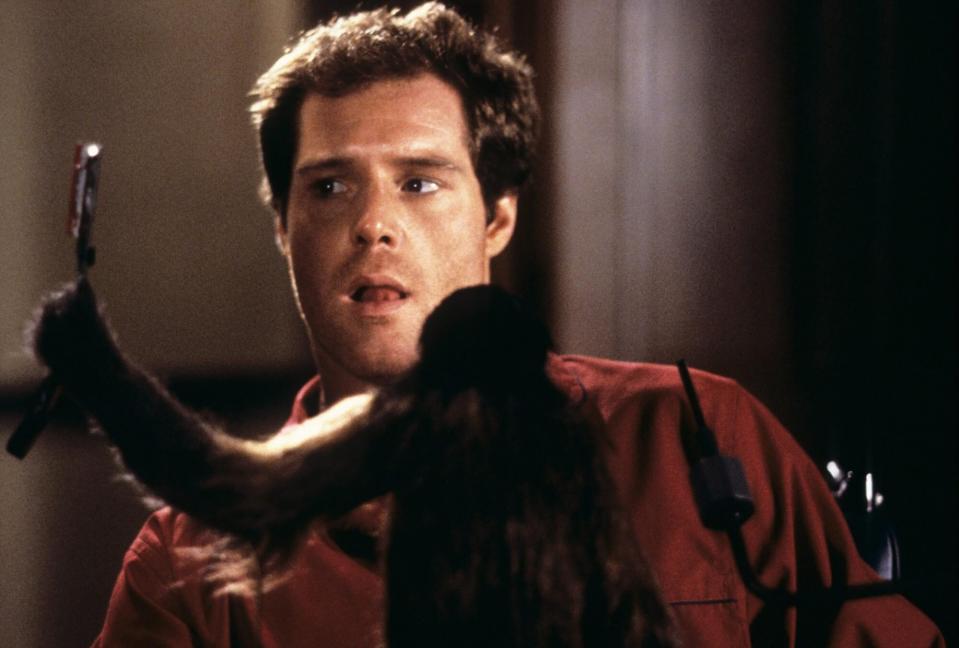
8. <i>The Crazies</i> (1973)
A man-made biological weapon is accidentally released into the water supply of sleepy Evans City, PA, causing the residents to turn violently insane. Mass murder and looting brings intervention from the United States government in the form of Colonel Peckem (Lloyd Hollar) and Dr. Watts (Richard France), both of whom are determined to contain the outbreak at any cost.
The Crazies is a grueling watch, but an equally important piece of work both for what it depicts on screen and for the pivotal point it represents in the career of its director. Romero's fourth picture is a searing indictment of military conflict both at home and abroad that has only adopted more resonance since its inception, and it's the film which primarily serves as the dry-run for the director's blend of rageful social satire and gonzo horror.
With an unsettling sound mix that seemingly continues to inspire Christoper Nolan to no end — all ambient chatter mixing with the clatter of ringing gunshots and masked soldiers barking muffled orders — and a flat, direct visual style which recalls harrowing newsreel footage of the conflict in Vietnam, The Crazies ranks alongside Tobe Hooper's original Texas Chainsaw Massacre as one of the most powerful of cinematic endurance tests.
If you loved The Crazies, you might also enjoy: Fernando Meirelles' Blindness (2008), based on the novel by José Saramago.
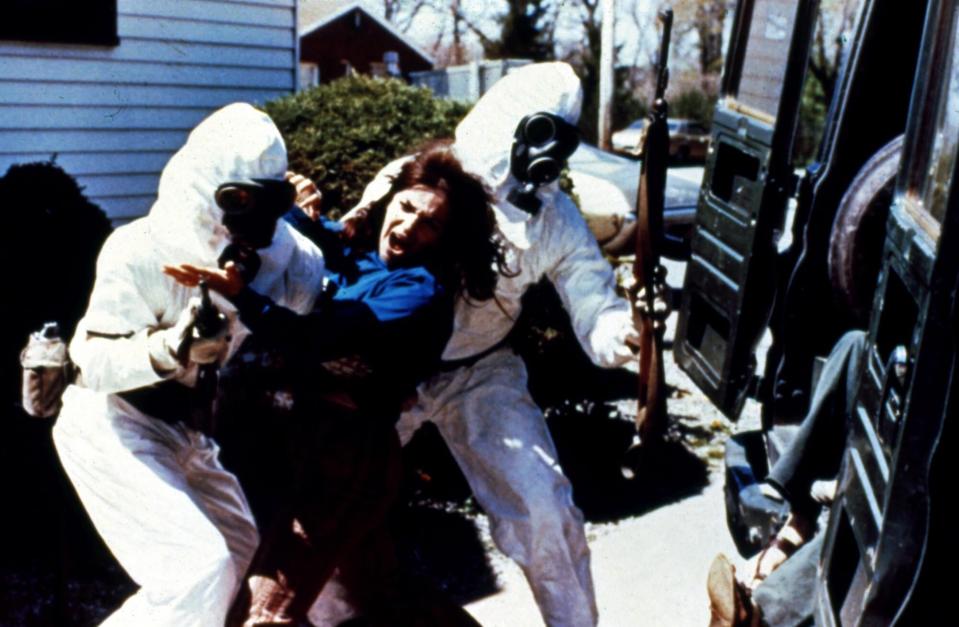
7. <i>Bruiser</i> (2000)
Perpetual people-pleaser Henry Creedlow (Jason Flemyng) awakes one morning to find his face replaced by a white mask. Relieved of his defining features and all vestiges of his identity, Henry takes the opportunity to dish out gory revenge upon the people whom he feels have wronged him.
Romero helmed this witty thriller after a variety of high-profile projects to which he was attached (including Resident Evil, The Mummy, and an adaptation of Stephen King's The Stand) all stalled in the development stages. After finally completing Bruiser, the director's film only saw release in Canada. When it eventually made a legitimate debut in the States two years later, it had long been available via pirating sites and bootleg copies which had ceaselessly eaten from the film's profits.
Why this never saw a major release is a mystery, because it is a stylish and admirably creepy film that feels like the work of a much younger, hungrier filmmaker. If Romero was perhaps dejected from developing projects that would go on to be highly successful under different hands, it can be seen in the verve and imagination with which he approaches the material in Bruiser.
If you loved Bruiser, you might also enjoy: Alejandro Amenábar's splendid Open Your Eyes (1997), which was remade by Cameron Crowe as Vanilla Sky (2001).

6. <i>Knightriders</i> (1981)
Billy (Ed Harris, who also appears in Creepshow) leads his medieval reenactment group, who conduct jousting competitions using their motorcycles, using his strict set of Arthurian ideals. As financial obligations rise and modern-day bothers begin to creep into the tight-knit family of sportsmen, Billy must fight against a sleazy promoter (Martin Ferrerro) wishing to represent the group, as well as Morgan (special effects legend Tom Savini), the leader of an opposing faction who feels he deserves to usurp Billy's throne.
A passion project for Romero, Knighriders was originally envisioned by the filmmaker as a true period piece that would give the Middle Ages a gritty, realistic screen treatment. This was reconsidered after Romero worked on several racing documentaries and felt that blending the two cultures would be appropriate. Taking inspiration from the Society for Creative Anachronism, a real living history group that recreates Medieval culture, Romero crafts a highly effective epic which stands apart from the rest of the director's ouevré for both its subject matter and style.
While the elongated 146-minute running time occasionally strains patience, it's an elegant and rousing picture that is unfailingly admirable for its commitment to such a niche concept. Savini, always an unexpectedly compelling screen presence in his acting roles, does some of his finest work here.
If you loved Knightriders, you might also enjoy: Timerider: The Adventure of Lyle Swann (1983), William Dear's inimitable motorcycle rider-gone-time-traveling epic.
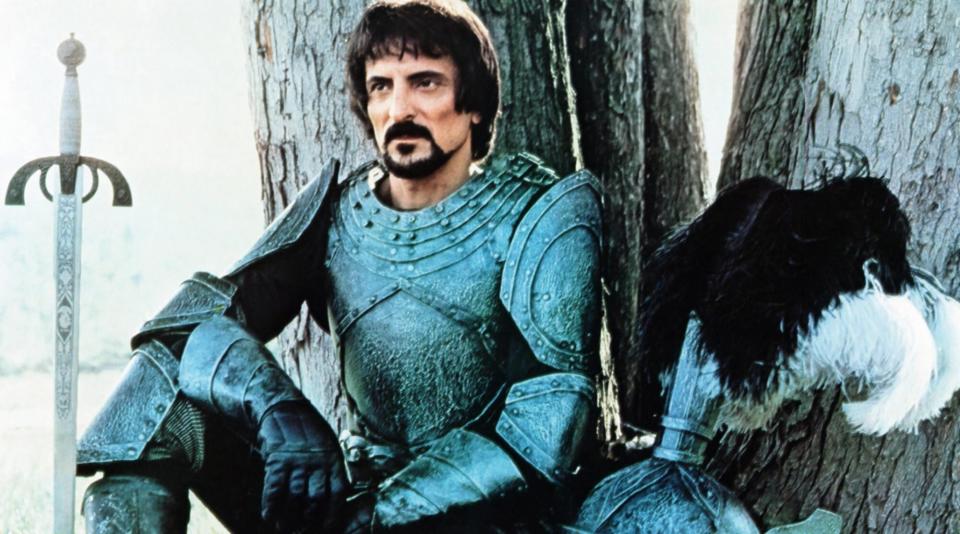
5. <i>Martin</i> (1978)
We first meet Martin (John Amplas) on a night train slicing the forearm of a prone woman, whom he allows to slowly bleed out as he drinks from her wound. Believing himself to be a vampire, Martin has gone to live with his much-older cousin Cuda (Romero repertory player Lincoln Maazel) and Cuda's orphaned granddaughter Christina (Christine Forrest, Romero's future wife). Cuda also believes Martin to be a vampire, and is tacitly accepting of his cousin's urges, even going so far as to nickname him "Nosferatu." Yet Cuda warns the boy that if he should ever plunder the town for victims, the older man will not hesitate to stake the young man in the heart. Tamping his blood-sucking urges, however, proves to be more difficult than Martin could have imagined.
An unnervingly eerie film that lingers long in the memory, Martin is one of the most gorgeous movies Romero produced and certainly his most emotionally impactful. (In its suburban-industrial setting, its central doomed romance and the naturalistic performances from the cast, the film in many ways appears to have directly influenced David Gordon Green's work, particularly his early films.)
This is one of Romero's less-discussed efforts (it's not even available to stream in the U.S.), but it's been just as influential on the horror and vampire genres as Night of the Living Dead and Dawn of the Dead were to the zombie genre. Martin is gorgeously made, a haunting and ethereal horror fairy tale that packs unexpected punches when you least expect them.
If you loved Martin, you might also enjoy: Abel Ferrara's The Addiction (1995)

4. <i>Creepshow</i> (1982)
Stephen King penned the screenplay for this seminal horror anthology, featuring five freakish stories to give you sleepless nights. Father's Day, in which sins of the past (and a splash of whiskey) resurrect a cake-craving daddy (John Lormer) who unleashes hell on his family; The Lonesome Death of Jordy Verrill, in which the title character (King himself) slowly morphs into an alien plant after coming into contact with a sizzling meteorite; Something to Tide You Over, concerning a particularly vindictive millionaire (Leslie Nielsen) who pursues ill-fated revenge against his wife (Dawn of the Dead's Gaylen Ross) and her lover (Ted Danson); The Crate, about a man-eating creature; and They're Creeping Up on You!, which details the misadventures of a businessman (E.G. Marshall) suffering from bacteriophobia who finds himself besieged by cockroaches. A wrap-around story finds young Billy Hopkins (Joe Hill, King's son and now a prolific author himself) gruesomely turning the tables on his violent father, who in the opening moments beats the boy for reading a Creepshow comic book.
Creepshow is an absolutely brilliant anthology, one that has rightfully become the poster child for that rich subgenre. It's a perfectly metered entertainment machine in which all of the stories are structured and paced perfectly, with the different tones and genres feeding into one another with seamless precision. This is Romero's most unambiguously fun film, and it delivers time and time again, truly evoking the illicit thrill of being a child up late at night reading a piece of violent pulp under the duvet cover.
Over 30 years after Michael Gornick's Creepshow 2 (1987), visual effects master and The Walking Dead director/EP Greg Nicotero rebooted the franchise in 2019 as an anthology series for Shudder. "The original Creepshow was developed out of pure inspiration and the fact that Steve and George really did it to pay tribute to EC comics and the stuff that they loved. So I feel like for me it's really my chance to tell stories based on the stuff that I love," Nicotero told EW in 2019.
Indeed, without the original Creepshow, Nicotero may not have had a career in film and television. "Creepshow is a project that's very personal to me. When I was 16 years old… I was invited to the set and visited as a horror fan only. I had no idea that my career was going to divert from my then current path as a doctor into the path that I'm on now… So everything in my life changed because of Creepshow. When Day of the Dead was green lit, George offered me a job, and I didn't hesitate. I had like a three-year time period between Creepshow and Day of the Dead where I got to be really good friends with Tom Savini. And I was getting glimpses into the magic of special effects and filmmaking. And so when Day of the Dead came up, I was like, 'Okay, I can't miss this opportunity once it came up. And here I am.'"
If you loved Creepshow, you might also enjoy: After Midnight (1989), Ken Wheat's rollicking anthology starring Pamela Adlon (Better Things) and Marg Helgenberger (CSI).
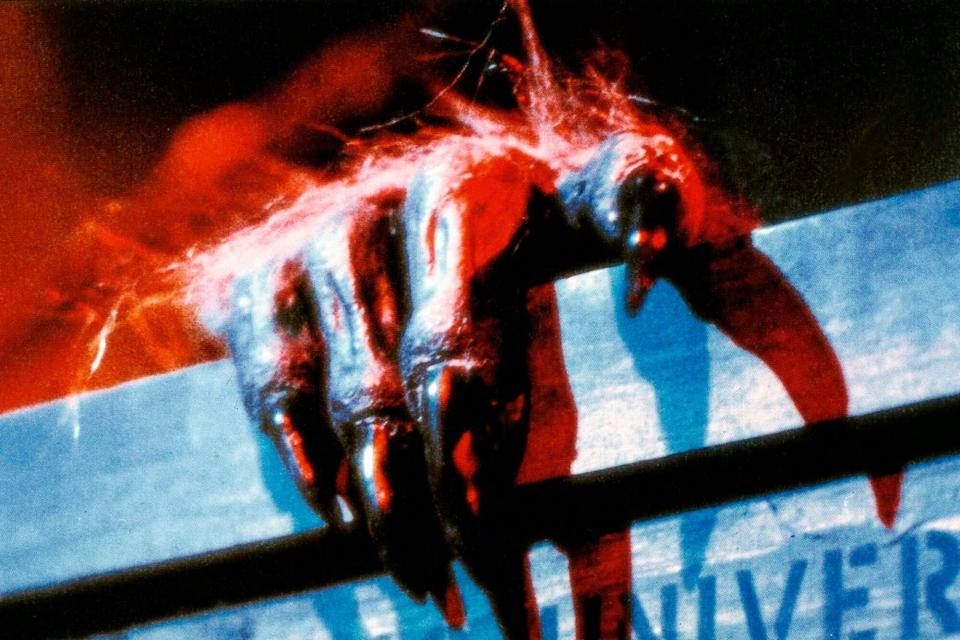
3. <i>Day of the Dead</i> (1985)
In Florida's Everglades, amidst the zombie apocalypse, a group of scientists and researchers are housed in a secure bunker where, under the protection of the military, they attempt to neutralize the threat of the reanimated dead and find a cure for the pandemic. Reflecting on his third ghoul picture, Romero described Day as a "tragedy about how a lack of human communication causes chaos and collapse even in this small little pie slice of a society."
Originally intended by Romero to be "the Gone with the Wind of zombie movies", the filmmaker's lofty ambitions were altered when the studio cut the budget from $7 million to just $3.5 million out of concerns that the director's gory vision would fail to secure the profits necessary to break even. It is one of the more dour works in Romero's library, one that evokes the nihilistic hopelessness of The Crazies far more than it recalls the rather jocular delights of Dawn or even the harrowing terror of Night. Day of the Dead is a classic of the genre, a hard-edged masterpiece which happens to boast the single best zombie performance of all time by Sherman Howard as Bub, an undead former soldier being kept in the underground bunker as part of an experiment to domesticate the ghouls.
Laurie Cardille, who stars as Dr. Sarah Bowman, spoke highly of her experience working with Romero in the documentary The Many Days of 'Day of the Dead'. He could've made me this sexy little twit bouncing around with a gun — much more the sexual element. But he made [Dr. Bowman] intelligent and strong. In fact, whenever I would try and make her a little more emotional, he would not allow me to do that."
If you loved Day of the Dead, you might also enjoy: Zombie (1979), Lucio Fulci's typically deranged contribution to the ghoul canon.

2. <i>Night of the Living Dead</i> (1968)
Romero's genre-defining ghoul picture (the film never uses the term "zombies") follows seven disparate strangers, including Barbra (Judith O'Dea) and Ben (Duane Jones), who find themselves trapped within a decrepit farmhouse as hordes of the slow-moving undead close in upon them. Several drafts of the script, centering on adolescent characters and aliens that harvest human bodies for food, were written by Romero and co-writer John Russo (himself the director of The Majorettes and Midnight) before the latter sequestered himself for several days and came up with the pared-down story we now know so well.
At the time of its release, modern audiences had yet to be exposed to the visceral horror that Romero's feature debut delivered. EW's Owen Gleiberman contextualized Night of the Living Dead's influence thusly: "Forty years after the revolution in low-budget nightmare splatter that was Night of the Living Dead, it's worth remembering that that film's garish power, apart from the sheer, outrageous, who will be the next to get chomped? insanity of its violence, arose out of the scary elusiveness of what it said about America. There was no exact correlation between the attack of flesh-hungry zombies — and the attack on them ("Kill the brain and you kill the ghoul!") — and the horrors of Vietnam or the general late-'60s breakdown. The metaphor was there, but it was ominously free-floating."
Having lapsed into the public domain before it was even released – due to the Manhattan-based Walter Reade Organization accidentally removing the copyright notice when they edited the film's print in order to change the title from Night of the Flesh Eaters — Night of the Living Dead has endured more home media releases and unofficial remakes than many ghouls have had warm entrail suppers. In 1990, Tom Savini himself directed a remake based off of Romero's original script but which amplified the violence for a modern audience and (most notably) gave the Barbra character a far more active role in her own fate than in the original film.
In the late '90s, to celebrate three decades of the Living Dead, Russo added 15 minutes of new footage to the film, including additional sequences of zombie mayhem, a prologue and an epilogue. Cinematographer Bill Hinzman told EW in April 1999 that the crew "looked at [the reshoots] as, had we the money in 1968, how would we have made it?"
If you loved Night of the Living Dead, you might also enjoy: Willard Huyck's supremely startling grindhouse classic Messiah of Evil (1973), a zombie picture that riffs on the formula established by Romero in Night but which was made early enough in the craze that it defies many of the genre's expectations.

1. <i>Dawn of the Dead</i> (1978)
After a mysterious epidemic that reanimates the dead as flesh-eating ghouls ravages the United States, SWAT officers Roger (Scott H. Reiniger) and Pete (Romero regular Ken Foree), as well as traffic reporter Steven (David Emge) and his television executive partner Francine (Gaylen Ross, also of Madman and now a prolific documentarian) take refuge in an abandoned shopping mall. At first, living is relatively easy, but as the months go on and the group begins to succumb to the paralysis of consumerism, they find that the greatest enemy of all may be those who are still living.
Romero's magnum opus finds the filmmaker in inimitable form, with all of the finest and most assured elements of his previous films congealing here into a delightful melange. As he regales us with hell-for-leather sequences of full-throttle action and high-octane gore, Romero questions his audience about their role in the theoretical apocalypse via his characters. The survivors who congregate, by force of habit rather than any grand plan, at the shopping mall in which the film takes place are barely more lifelike than the ghouls who wish to feast upon them. Ross makes for a particularly effective presence here; she walks a brilliant, poignant line between the catatonic-from-shock Barbara in Night of the Living Dead and the more take-charge initiative of Dr. Bowman in Day of the Dead.
Savini made his special effects debut here and took inspiration from the atrocities he witnessed during his time in Vietnam. Much has been said in regards to Dawn's blood effects, which Savini himself has equated to melted red crayons, but the ghoulish results have managed to hold up across various restorations and even a luscious 3D print that has been making the rounds in recent years. Romero has made several classic films, but Dawn of the Dead is his masterwork, weaving bristling cultural commentary with some of the finest sequences any horror film has delivered.
If you loved Dawn of the Dead, you might also enjoy: Jorge Grau's Let Sleeping Corpses Lie (1974), which is commonly re-released under the titles The Living Dead at Manchester Morgue and Don't Open the Window.

Related content:

